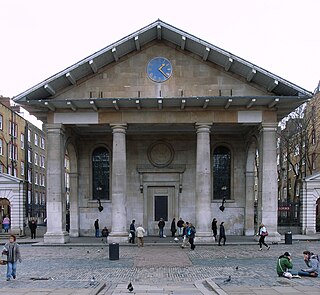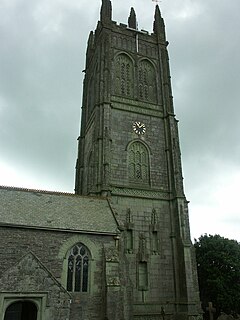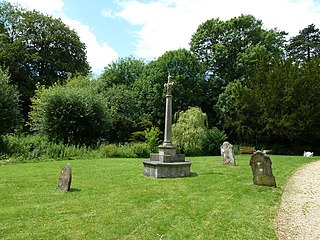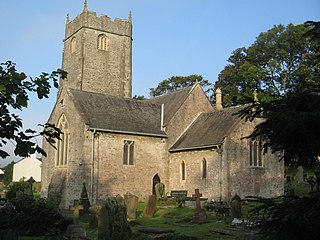
Glasnevin is a neighbourhood of Dublin, Ireland, situated on the River Tolka. While primarily residential, Glasnevin is also home to the National Botanic Gardens, national meteorological office and a range of other State bodies, and Dublin City University has its main campus and other facilities in and near the area.

Lambeth Palace is the official London residence of the Archbishop of Canterbury in England, in north Lambeth, on the south bank of the River Thames, 400 yards south-east of the Palace of Westminster, which houses the Houses of Parliament, on the opposite bank.

Shenley is a village and civil parish in Hertfordshire, England, between Barnet and St Albans. The village is located 18.7 miles from Central London.

St Paul's Church is a church located in Bedford Street, Covent Garden, London, WC2E 9ED. It was designed by Inigo Jones as part of a commission for the 4th Earl of Bedford in 1631 to create "houses and buildings fit for the habitations of Gentlemen and men of ability". As well as being the parish church of Covent Garden, the church has gained the nickname of "the actors' church" by a long association with the theatre community.

Probus is a civil parish and village in Cornwall, England, in the United Kingdom. It has the tallest church tower in Cornwall. The tower is 129 feet (39 m) high, and richly decorated with carvings. The place name originates from the church's dedication to Saint Probus. The parish population at the 2011 census was 2,299, whereas the ward population taken at the same census was 3,953.

St Leonard, Foster Lane, was a Church of England church dedicated to Leonard of Noblac on the west side of Foster Lane in the Aldersgate ward of the City of London. It was destroyed in the Great Fire of 1666 and not rebuilt.

Dommershausen is an Ortsgemeinde – a municipality belonging to a Verbandsgemeinde, a kind of collective municipality – in the Rhein-Hunsrück-Kreis (district) in Rhineland-Palatinate, Germany. It belongs to the Verbandsgemeinde of Kastellaun, whose seat is in the like-named town.

Headbourne Worthy is a village and former manor within the City of Winchester district of Hampshire, England. The parish also includes the former manor of Worthy Pauncefoot.

St Ann Blackfriars was a church in the City of London, in what is now Ireland Yard in the ward of Farringdon Within. The church began as a medieval parish chapel, dedicated to St Ann, within the Dominican Black Friars church. The new parish church was established in the 16th century to serve the inhabitants of the precincts of the former Dominican monastery, following its dissolution under King Henry VIII. It was near the Blackfriars Theatre, a fact which displeased its congregation. It was destroyed in the Great Fire of London of 1666.

Swimbridge is a village, parish and former manor in Devon, England. It is situated 4 miles (6.4 km) south-east of Barnstaple and twinned with the town of St.Honorine Du Fay in Normandy, France. It was the home of the Rev. John "Jack" Russell who first bred the Jack Russell Terrier.

St Laurence Pountney was a Church of England parish church in the Candlewick Ward of the City of London. It was destroyed in the Great Fire of 1666, and not rebuilt.

St. Leonard, Eastcheap, sometimes referred to as St Leonard Milkchurch, was a parish church in the City of London. Of medieval origin, it was destroyed in the Great Fire of London in 1666 and not rebuilt. The site of the church was retained as a graveyard.

St John the Baptist Church is a Grade I listed parish church in Cardiff, Wales, the only church dating to pre-Medieval times in Cardiff city centre and the only medieval building other than Cardiff Castle.

Burnley, in Lancashire, England, has a long history of religious worship, dating from at least before 1122 in the case of the Church of England. The chapel at Towneley Hall was the centre for Roman Catholic worship in Burnley until modern times. Well before the Industrial Revolution, the town saw the emergence of many non-conformist churches and chapels. In 1891 the town was the location of the meeting which saw the creation of the Baptist Union of Great Britain and Ireland. In the late 19th century a Jewish synagogue was established, and in recent times evangelical and free churches have appeared, as well as a large purpose-built mosque.

St John's Wood Church Grounds is a disused graveyard which is now a public park in St. John's Wood in London. It is a Site of Borough Importance for Nature Conservation, Grade 1, and the only Local Nature Reserve in the City of Westminster. Since 2004 it has received the Green Flag Award for excellent green spaces. It is owned and managed by Westminster Council.

St John's Gardens in central Manchester, England, lies between Lower Byrom Street, Byrom Street and Quay Street. Previously occupied by St John's Church and its graveyard between 1769 and 1931, the site was redeveloped into a formal garden in 1932. It contains a central memorial to the church and those buried in its graveyard, whose tombstones have been covered over by 18 inches (460 mm) of soil except for that of John Owens, founder of Owen's College.

St John's Church is located in St John's, Woking, England. The church is in the parish of St John's, Diocese of Guildford, which in turn is in the Province of Canterbury. The local village is named after the church.

All Saints Anglican Church and cemetery Yandilla is a heritage-listed Anglican church at Gore Highway, Yandilla, Toowoomba Region, Queensland, Australia. It was built about 1878 by John Baillie. It is also known as All Saints Church of England. It was added to the Queensland Heritage Register on 21 October 1992.

The Church of St John the Baptist is a medieval church in Llanblethian in the Vale of Glamorgan, south Wales. Believed to have been built in the 12th century, the church boasts an unusual tower, consistent with the style more common in the south west of England. It underwent extensive restoration in the late 19th century, undertaken by C. B. Fowler of Cardiff. The Church of St John was listed as a Grade I building on 22 February 1963.

The Burdett Coutts Memorial Sundial is a structure built in Old St Pancras churchyard in 1877–79, at the behest of Baroness Burdett-Coutts. The former churchyard included the burial ground for St Giles-in-the-Fields, where many Catholics and French émigrés were buried. The graveyard closed to burials in 1850, but some graves were disturbed by a cutting of the Midland Railway in 1865 as part of the works to construct its terminus at St Pancras railway station. The churchyard was acquired by the parish authorities in 1875 and reopened as a public park in June 1877. The high Victorian Gothic memorial was built from 1877 and unveiled in 1879. The obelisk acts as a memorial to people buried near the church whose graves were disturbed; the names of over 70 of them are listed on the memorial, including the Chevalier d'Éon, Sir John Soane, John Flaxman, Sir John Gurney, and James Leoni.



















